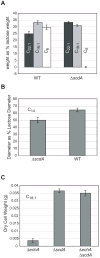A single acyl-CoA dehydrogenase is required for catabolism of isoleucine, valine and short-chain fatty acids in Aspergillus nidulans
- PMID: 17656140
- PMCID: PMC2905684
- DOI: 10.1016/j.fgb.2007.06.004
A single acyl-CoA dehydrogenase is required for catabolism of isoleucine, valine and short-chain fatty acids in Aspergillus nidulans
Abstract
An acyl-CoA dehydrogenase has been identified as part of the mitochondrial beta-oxidation pathway in the ascomycete fungus Aspergillus nidulans. Disruption of the scdA gene prevented use of butyric acid (C(4)) and hexanoic acid (C(6)) as carbon sources and reduced cellular butyryl-CoA dehydrogenase activity by 7.5-fold. While the mutant strain exhibited wild-type levels of growth on erucic acid (C(22:1)) and oleic acid (C(18:1)), some reduction in growth was observed with myristic acid (C(14)). The DeltascdA mutation was found to be epistatic to a mutation downstream in the beta-oxidation pathway (disruption of enoyl-CoA hydratase). The DeltascdA mutant was also unable to use isoleucine or valine as a carbon source. Transcription of scdA was observed in the presence of either fatty acids or amino acids. When the mutant was grown in medium containing either isoleucine or valine, organic acid analysis of culture supernatants showed accumulation of 2-oxo acid intermediates of branched chain amino acid catabolism, suggesting feedback inhibition of the upstream branched-chain alpha-keto acid dehydrogenase.
Figures






Similar articles
-
Mitochondrial beta-oxidation in Aspergillus nidulans.Mol Microbiol. 2004 Dec;54(5):1173-85. doi: 10.1111/j.1365-2958.2004.04340.x. Mol Microbiol. 2004. PMID: 15554960
-
Induction of beta-oxidation enzymes and microbody proliferation in Aspergillus nidulans.Arch Microbiol. 1996 Nov;166(5):336-41. doi: 10.1007/s002030050392. Arch Microbiol. 1996. PMID: 8929280
-
Genes encoding acyl-CoA dehydrogenase (AcdH) homologues from Streptomyces coelicolor and Streptomyces avermitilis provide insights into the metabolism of small branched-chain fatty acids and macrolide antibiotic production.Microbiology (Reading). 1999 Sep;145 ( Pt 9):2323-2334. doi: 10.1099/00221287-145-9-2323. Microbiology (Reading). 1999. PMID: 10517585
-
Peroxisomal lipid degradation via beta- and alpha-oxidation in mammals.Cell Biochem Biophys. 2000;32 Spring:73-87. doi: 10.1385/cbb:32:1-3:73. Cell Biochem Biophys. 2000. PMID: 11330072 Review.
-
Structure and mechanism of action of the acyl-CoA dehydrogenases.FASEB J. 1995 Jun;9(9):718-25. doi: 10.1096/fasebj.9.9.7601336. FASEB J. 1995. PMID: 7601336 Review.
Cited by
-
Physiological role of Acyl coenzyme A synthetase homologs in lipid metabolism in Neurospora crassa.Eukaryot Cell. 2013 Sep;12(9):1244-57. doi: 10.1128/EC.00079-13. Epub 2013 Jul 19. Eukaryot Cell. 2013. PMID: 23873861 Free PMC article.
-
A Fox2-dependent fatty acid ß-oxidation pathway coexists both in peroxisomes and mitochondria of the ascomycete yeast Candida lusitaniae.PLoS One. 2014 Dec 8;9(12):e114531. doi: 10.1371/journal.pone.0114531. eCollection 2014. PLoS One. 2014. PMID: 25486052 Free PMC article.
-
Peroxisomal and mitochondrial β-oxidation pathways influence the virulence of the pathogenic fungus Cryptococcus neoformans.Eukaryot Cell. 2012 Aug;11(8):1042-54. doi: 10.1128/EC.00128-12. Epub 2012 Jun 15. Eukaryot Cell. 2012. PMID: 22707485 Free PMC article.
-
Genetic analysis of the role of peroxisomes in the utilization of acetate and fatty acids in Aspergillus nidulans.Genetics. 2008 Mar;178(3):1355-69. doi: 10.1534/genetics.107.085795. Epub 2008 Feb 3. Genetics. 2008. PMID: 18245820 Free PMC article.
-
Screening for Volatile α-Unsaturated Ester-Producing Yeasts from the Feces of Wild Animals in South Africa.Life (Basel). 2022 Nov 30;12(12):1999. doi: 10.3390/life12121999. Life (Basel). 2022. PMID: 36556363 Free PMC article.
References
-
- Andresen BS, Christensen E, Corydon TJ, Bross P, Pilgaard B, Wanders RJ, Ruiter JP, Simonsen H, Winter V, Knudsen I, Schroeder LD, Gregersen N, Skovby F. Isolated 2-methylbutyrylglycinuria caused by short/branched-chain acyl-CoA dehydrogenase deficiency: identification of a new enzyme defect, resolution of its molecular basis, and evidence for distinct acyl-CoA dehydrogenases in isoleucine and valine metabolism. Am J Hum Genet. 2000;67:1095–1103. - PMC - PubMed
-
- Bachhawat BK, Coon MJ, Kupiecki FP, Nagle R, Robinson WG. Coenzyme A thiol esters of isobutyric, methacrylic, and beta-hydroxyisobutyric acids as intermediates in the enzymatic degradation of valine. J Biol Chem. 1957;224:1–11. - PubMed
-
- Battaile KP, Mohsen AA, Vockley J. Functional role of the active site glutamate-368 in rat short chain acyl-CoA dehydrogenase. Biochemistry. 1996;35:15356–15363. - PubMed
-
- Battaile KP, Molin-Case J, Paschke R, Wang M, Bennett D, Vockley J, Kim JJP. Crystal structure of rat short chain acyl-CoA dehydrogenase complexed with acetoacetyl-CoA: comparison with other acyl-CoA dehydrogenases. J Biol Chem. 2002;277:12200–12207. - PubMed
-
- Brock M, Fischer R, Linder D, Buckel W. Methylcitrate synthase from Aspergillus nidulans: implications for proprionate as an antifungal agent. Mol Microbiol. 2000;35:961–973. - PubMed
Publication types
MeSH terms
Substances
Grants and funding
LinkOut - more resources
Full Text Sources
Other Literature Sources
Molecular Biology Databases
Miscellaneous

